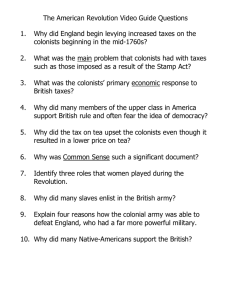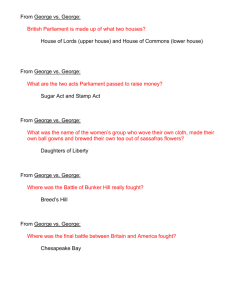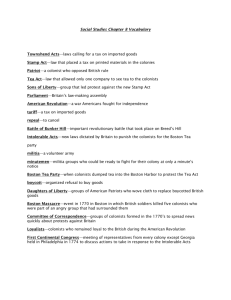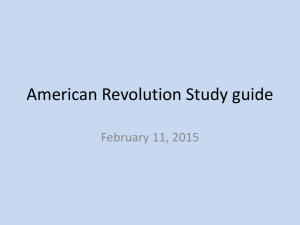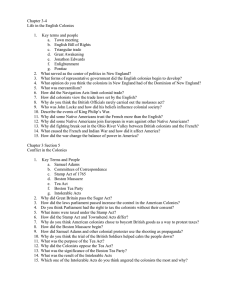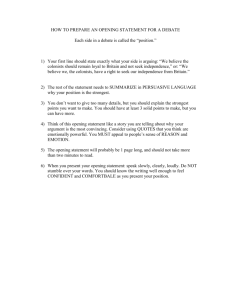Welcome to a Revolution…
advertisement
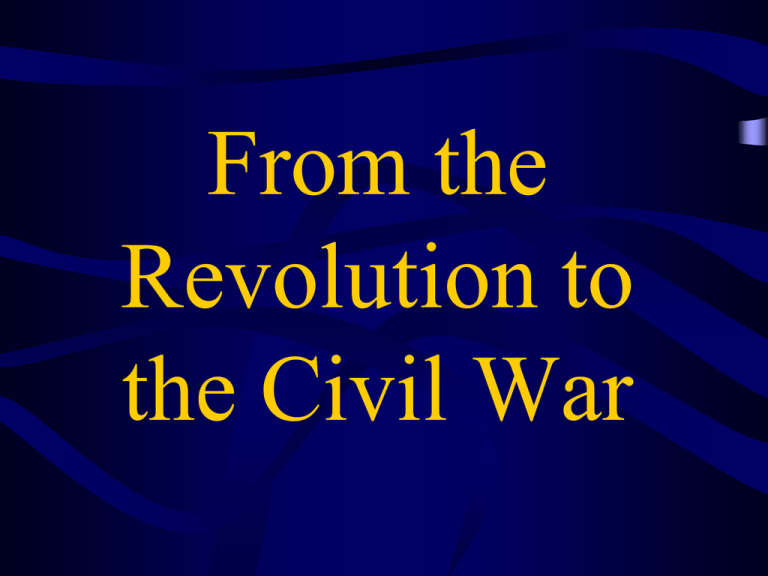
From the Revolution to the Civil War Part I: The American Revolution The French and Indian War • Britain helped the colonists defeat the French • Britain needed money to pay for war expenses • They taxed colonists, restricted settlements and limited self-govt. Britain Passes New Laws • The Proclamation of 1763 prohibited settlement beyond the Appalachian Mountains. • Prime Minister Grenville wanted colonists to compensate for British troops through the Sugar Act, which taxed sugar and molasses imported from the French and Spanish West Indies. The Stamp Act • Parliament passed the Stamp Act as another way to bring in money from the colonies. • Required a government tax stamp on certain documents: contracts and licenses, newspapers, almanacs, printed sermons, and playing cards Colonists Protest Openly • The Stamp Act Congress was organized by the Massachusetts Assembly to send a petition to the king and Parliament. • The Sons of Liberty, a group made up of unskilled workers, artisans, small farmers, merchants, and lawyers, organized a boycott of British goods and put pressure on merchants who did not join in. • The Stamp Act was repealed after British merchants saw sales drop because of the boycotts. The Townshend Acts • Taxed lead, paint, paper, glass, and tea that were imported from Britain • Smugglers increased their activities to avoid the tax leading to more troops in Boston. The Boston Massacre In Boston, where tensions were already high, colonists began throwing snowballs at a British sentry guarding the customs house. After British solders arrived to help, they fired into the crowd, killing five. This incident was used as an example of British cruelty. The Colonists Respond • Colonial boycotts left a British tea company with millions of pounds of unsold tea. The Tea Act (1773) enabled the company to sell tea directly to colonists. • Many colonists did not buy the tea. • In December 1773 about 70 colonists boarded British ships loaded with the tea and dumped it into Boston Harbor. The event is known as the Boston Tea Party. King George III passes the “Intolerable Acts” • The Royal Navy blockaded the Boston Harbor so no colonial goods could be sent out until the tea was paid for. • Colonists had to quarter the British soldiers. • The King assigned British General Gage to be Massachusetts First Continental Congress meets in Philadelphia • Brought the colonists together as Americans • All delegates agreed that Parliament was exerting too much control • It issued a Declaration of Rights protesting Great Britain’s actions • Agreed not to import or use British goods • Agreed to stop exports to Britain • Formed a force of minutemen, colonial soldiers who would be ready to resist a British attack with short notice Conflict at Lexington and Concord In April, British troops were ordered to Lexington and Concord to seize stores of colonial gunpowder and to capture Samuel Adams and John Hancock. At Lexington, open conflict occurred and eight Americans were killed. At Concord, the British troops were forced to retreat and lost 70 men. This was the first instance of open warfare. The Second Continental Congress Takes Action • Formed the Continental Army • Appointed George Washington commander in chief • Issued a Continental (national) currency • Wrote A Declaration of the Causes and Necessity of Taking Up Arms • Proposed reconciliation with King George III in the Olive Branch Petition • King George III declared colonies to be in rebellion • Parliament passed a law banning colonial trade outside the British Empire. The Declaration of Independence Written primarily by Thomas Jefferson, the Declaration is a formal explanation of why Congress had voted on July 2 to declare independence from Great Britain, more than a year after the outbreak of the American Revolutionary War. The Treaty of Paris In 1783, the Treaty of Paris ended the war and recognized the sovereignty of the United States over the territory bounded by what is now Canada to the north, Florida to the south, and the Mississippi River to the west. Part II: The Early National Era The Constitution The United States Constitution was written in 1787, but it did not take effect until after it was ratified in 1789, when it replaced the Articles of Confederation. The Constitution created a much more powerful and efficient central government, one with a strong president, and powers of taxation. Alexander Hamilton Hamilton was the primary author of the economic policies of the George Washington Administration, especially the funding of the state debts by the Federal government, and the establishment of a national bank, a system of tariffs, and friendly trade relations with John Adams Adams was elected president in 1796. He signed the controversial Alien and Sedition Acts, and built up the army and navy especially in the face of an undeclared naval war (called the "Quasi War") with France. The major accomplishment of his presidency was his peaceful resolution of this conflict in the face of Hamilton's opposition. The Louisiana Purchase The War of 1812 The Americans declared war in 1812 for a number of reasons, including a desire for expansion into the Northwest Territory, trade restrictions because of Great Britain's ongoing war with France, impressment of American merchant sailors into the Royal Navy, British support of American Indian tribes against American expansion, and the humiliation of American honor. The War ended in a draw after bitter fighting that lasted until January 8, 1815, during the Battle of New Orleans. James Madison As president (1809–1817), he led the poorly prepared nation into the War of 1812 against Great Britain. During and after the war, Madison reversed many of his positions. By 1815, he supported the creation of the second National Bank, a strong military, and a high tariff to protect the new factories opened during the war. The Monroe Doctrine The Monroe Doctrine, expressed in 1823, proclaimed the United States' opinion that European powers should no longer colonize or interfere in the Americas. The Doctrine was adopted in response to American and British fears over Russian and French expansion into the Western Hemisphere. The Indian Removal Act The Act was signed into law by President Andrew Jackson on May 26, 1830. It paved the way for the reluctant—and often forcible— emigration of tens of thousands of American Indians to the West. The Abolitionists Part III: The Civil War US Secession map Jefferson Davis On February 18, 1861, after he resigned from the U.S. Senate, Davis was selected provisional President of the Confederate States of America; he was elected without opposition to a sixyear term that November. During his presidency, Davis took charge of the Confederate war plans but was unable to find a strategy to stop the larger, more powerful and better organized Abraham Lincoln Lincoln was an outspoken opponent of the expansion of slavery. As a result, he secured the Republican nomination and was elected president in 1860. As president he concentrated on the military and political dimensions of the war effort. He issued his Emancipation Proclamation in 1863, and promoted the passage of the Thirteenth Amendment to the United States Constitution, abolishing slavery. The Emancipation Proclamation The Emancipation Proclamation is an executive order issued by United States President Abraham Lincoln during the American Civil War under his war powers. It proclaimed the freedom of 3.1 million of the nation's 4 million slaves, and immediately freed 50,000 of them, with the rest Robert Edward Lee Robert Lee was a career United States Army officer and combat engineer. He became the commanding general of the Confederate army in the American Civil War. Lee distinguished himself as an exceptional soldier in the U.S. Army for 32 years. He is best known for having commanded the Confederate Army of Northern Virginia in the American Civil War. Ulysses S. Grant Ulysses Grant was the 18th President of the United States (1869– 1877) as well as military commander during the Civil War and post-war Reconstruction periods. Under Grant's command, the Union Army defeated the Confederate military and ended the Confederate States of Parlor of the (reconstructed) McLean House, the site of Confederate General Robert E. Lee's surrender. THE END
